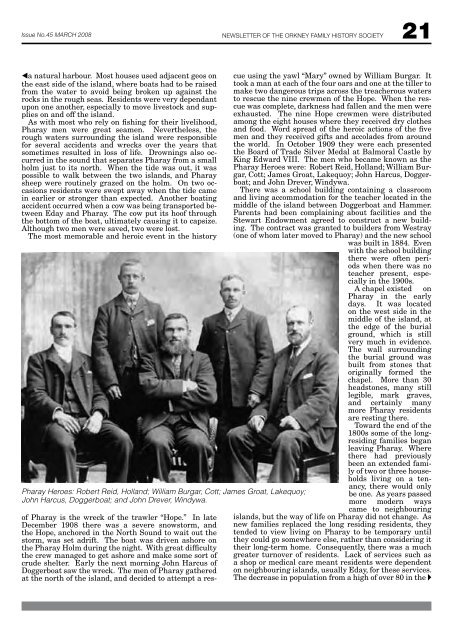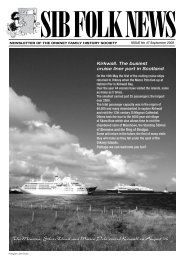The Hamnavoe berthed in Stromness on a fine Spring morning with ...
The Hamnavoe berthed in Stromness on a fine Spring morning with ...
The Hamnavoe berthed in Stromness on a fine Spring morning with ...
Create successful ePaper yourself
Turn your PDF publications into a flip-book with our unique Google optimized e-Paper software.
Issue No.45 MARCH 2008 NEWSLETTER OF THE ORKNEY FAMILY HISTORY SOCIETY 21<br />
Fa natural harbour. Most houses used adjacent geos <strong>on</strong><br />
the east side of the island, where boats had to be raised<br />
from the water to avoid be<str<strong>on</strong>g>in</str<strong>on</strong>g>g broken up aga<str<strong>on</strong>g>in</str<strong>on</strong>g>st the<br />
rocks <str<strong>on</strong>g>in</str<strong>on</strong>g> the rough seas. Residents were very dependant<br />
up<strong>on</strong> <strong>on</strong>e another, especially to move livestock and supplies<br />
<strong>on</strong> and off the island.<br />
As <strong>with</strong> most who rely <strong>on</strong> fish<str<strong>on</strong>g>in</str<strong>on</strong>g>g for their livelihood,<br />
Pharay men were great seamen. Nevertheless, the<br />
rough waters surround<str<strong>on</strong>g>in</str<strong>on</strong>g>g the island were resp<strong>on</strong>sible<br />
for several accidents and wrecks over the years that<br />
sometimes resulted <str<strong>on</strong>g>in</str<strong>on</strong>g> loss of life. Drown<str<strong>on</strong>g>in</str<strong>on</strong>g>gs also occurred<br />
<str<strong>on</strong>g>in</str<strong>on</strong>g> the sound that separates Pharay from a small<br />
holm just to its north. When the tide was out, it was<br />
possible to walk between the two islands, and Pharay<br />
sheep were rout<str<strong>on</strong>g>in</str<strong>on</strong>g>ely grazed <strong>on</strong> the holm. On two occasi<strong>on</strong>s<br />
residents were swept away when the tide came<br />
<str<strong>on</strong>g>in</str<strong>on</strong>g> earlier or str<strong>on</strong>ger than expected. Another boat<str<strong>on</strong>g>in</str<strong>on</strong>g>g<br />
accident occurred when a cow was be<str<strong>on</strong>g>in</str<strong>on</strong>g>g transported between<br />
Eday and Pharay. <str<strong>on</strong>g>The</str<strong>on</strong>g> cow put its hoof through<br />
the bottom of the boat, ultimately caus<str<strong>on</strong>g>in</str<strong>on</strong>g>g it to capsize.<br />
Although two men were saved, two were lost.<br />
<str<strong>on</strong>g>The</str<strong>on</strong>g> most memorable and heroic event <str<strong>on</strong>g>in</str<strong>on</strong>g> the history<br />
Pharay Heroes: Robert Reid, Holland; William Burgar, Cott; James Groat, Lakequoy;<br />
John Harcus, Doggerboat; and John Drever, W<str<strong>on</strong>g>in</str<strong>on</strong>g>dywa.<br />
of Pharay is the wreck of the trawler “Hope.” In late<br />
December 1908 there was a severe snowstorm, and<br />
the Hope, anchored <str<strong>on</strong>g>in</str<strong>on</strong>g> the North Sound to wait out the<br />
storm, was set adrift. <str<strong>on</strong>g>The</str<strong>on</strong>g> boat was driven ashore <strong>on</strong><br />
the Pharay Holm dur<str<strong>on</strong>g>in</str<strong>on</strong>g>g the night. With great difficulty<br />
the crew managed to get ashore and make some sort of<br />
crude shelter. Early the next morn<str<strong>on</strong>g>in</str<strong>on</strong>g>g John Harcus of<br />
Doggerboat saw the wreck. <str<strong>on</strong>g>The</str<strong>on</strong>g> men of Pharay gathered<br />
at the north of the island, and decided to attempt a res-<br />
cue us<str<strong>on</strong>g>in</str<strong>on</strong>g>g the yawl “Mary” owned by William Burgar. It<br />
took a man at each of the four oars and <strong>on</strong>e at the tiller to<br />
make two dangerous trips across the treacherous waters<br />
to rescue the n<str<strong>on</strong>g>in</str<strong>on</strong>g>e crewmen of the Hope. When the rescue<br />
was complete, darkness had fallen and the men were<br />
exhausted. <str<strong>on</strong>g>The</str<strong>on</strong>g> n<str<strong>on</strong>g>in</str<strong>on</strong>g>e Hope crewmen were distributed<br />
am<strong>on</strong>g the eight houses where they received dry clothes<br />
and food. Word spread of the heroic acti<strong>on</strong>s of the five<br />
men and they received gifts and accolades from around<br />
the world. In October 1909 they were each presented<br />
the Board of Trade Silver Medal at Balmoral Castle by<br />
K<str<strong>on</strong>g>in</str<strong>on</strong>g>g Edward VIII. <str<strong>on</strong>g>The</str<strong>on</strong>g> men who became known as the<br />
Pharay Heroes were: Robert Reid, Holland; William Burgar,<br />
Cott; James Groat, Lakequoy; John Harcus, Doggerboat;<br />
and John Drever, W<str<strong>on</strong>g>in</str<strong>on</strong>g>dywa.<br />
<str<strong>on</strong>g>The</str<strong>on</strong>g>re was a school build<str<strong>on</strong>g>in</str<strong>on</strong>g>g c<strong>on</strong>ta<str<strong>on</strong>g>in</str<strong>on</strong>g><str<strong>on</strong>g>in</str<strong>on</strong>g>g a classroom<br />
and liv<str<strong>on</strong>g>in</str<strong>on</strong>g>g accommodati<strong>on</strong> for the teacher located <str<strong>on</strong>g>in</str<strong>on</strong>g> the<br />
middle of the island between Doggerboat and Hammer.<br />
Parents had been compla<str<strong>on</strong>g>in</str<strong>on</strong>g><str<strong>on</strong>g>in</str<strong>on</strong>g>g about facilities and the<br />
Stewart Endowment agreed to c<strong>on</strong>struct a new build<str<strong>on</strong>g>in</str<strong>on</strong>g>g.<br />
<str<strong>on</strong>g>The</str<strong>on</strong>g> c<strong>on</strong>tract was granted to builders from Westray<br />
(<strong>on</strong>e of whom later moved to Pharay) and the new school<br />
was built <str<strong>on</strong>g>in</str<strong>on</strong>g> 1884. Even<br />
<strong>with</strong> the school build<str<strong>on</strong>g>in</str<strong>on</strong>g>g<br />
there were often periods<br />
when there was no<br />
teacher present, especially<br />
<str<strong>on</strong>g>in</str<strong>on</strong>g> the 1900s.<br />
A chapel existed <strong>on</strong><br />
Pharay <str<strong>on</strong>g>in</str<strong>on</strong>g> the early<br />
days. It was located<br />
<strong>on</strong> the west side <str<strong>on</strong>g>in</str<strong>on</strong>g> the<br />
middle of the island, at<br />
the edge of the burial<br />
ground, which is still<br />
very much <str<strong>on</strong>g>in</str<strong>on</strong>g> evidence.<br />
<str<strong>on</strong>g>The</str<strong>on</strong>g> wall surround<str<strong>on</strong>g>in</str<strong>on</strong>g>g<br />
the burial ground was<br />
built from st<strong>on</strong>es that<br />
orig<str<strong>on</strong>g>in</str<strong>on</strong>g>ally formed the<br />
chapel. More than 30<br />
headst<strong>on</strong>es, many still<br />
legible, mark graves,<br />
and certa<str<strong>on</strong>g>in</str<strong>on</strong>g>ly many<br />
more Pharay residents<br />
are rest<str<strong>on</strong>g>in</str<strong>on</strong>g>g there.<br />
Toward the end of the<br />
1800s some of the l<strong>on</strong>gresid<str<strong>on</strong>g>in</str<strong>on</strong>g>g<br />
families began<br />
leav<str<strong>on</strong>g>in</str<strong>on</strong>g>g Pharay. Where<br />
there had previously<br />
been an extended family<br />
of two or three households<br />
liv<str<strong>on</strong>g>in</str<strong>on</strong>g>g <strong>on</strong> a ten-<br />
ancy, there would <strong>on</strong>ly<br />
be <strong>on</strong>e. As years passed<br />
more modern ways<br />
came to neighbour<str<strong>on</strong>g>in</str<strong>on</strong>g>g<br />
islands, but the way of life <strong>on</strong> Pharay did not change. As<br />
new families replaced the l<strong>on</strong>g resid<str<strong>on</strong>g>in</str<strong>on</strong>g>g residents, they<br />
tended to view liv<str<strong>on</strong>g>in</str<strong>on</strong>g>g <strong>on</strong> Pharay to be temporary until<br />
they could go somewhere else, rather than c<strong>on</strong>sider<str<strong>on</strong>g>in</str<strong>on</strong>g>g it<br />
their l<strong>on</strong>g-term home. C<strong>on</strong>sequently, there was a much<br />
greater turnover of residents. Lack of services such as<br />
a shop or medical care meant residents were dependent<br />
<strong>on</strong> neighbour<str<strong>on</strong>g>in</str<strong>on</strong>g>g islands, usually Eday, for these services.<br />
<str<strong>on</strong>g>The</str<strong>on</strong>g> decrease <str<strong>on</strong>g>in</str<strong>on</strong>g> populati<strong>on</strong> from a high of over 80 <str<strong>on</strong>g>in</str<strong>on</strong>g> the A



